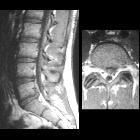cervicaler Discusprolaps

cervicaler Discusprolaps
Diskusprolaps Radiopaedia • CC-by-nc-sa 3.0 • de
Disc herniation refers to the displacement of intervertebral disc material beyond the normal confines of the disc but involving less than 25% of the circumference (to distinguish it from a disc bulge). A herniation may contain nucleus pulposus, vertebral endplate cartilage, apophyseal bone/osteophyte and annulus fibrosus.
Disc herniations can be divided into groups in a variety of ways. Commonly they are divided into protrusion vs extrusion:
- protrusion
- base wider than herniation
- confined to disc level
- outer annular fibers intact
- extrusion
- base (a.k.a. neck) narrower than herniation 'dome'
- may extend above or below endplates or adjacent vertebrae
- complete annular tear with passage of nuclear material beyond disc annulus
- disc material can then migrate away from annulus or become sequestered
Herniations can further be classified as:
- contained
- with intact outer fibers of annulus fibrosus and posterior longitudinal ligament, or
- with intact posterior longitudinal ligament alone
- not contained
- tear of outer fibers of annulus fibrosus and posterior longitudinal ligament
See also
Siehe auch:
- Diskusprolaps
- foraminaler Diskusprolaps
- intraforaminaler Diskusprolaps
- mediolateraler Diskusprolaps
- medianer Diskusprolaps
- lateraler Diskusprolaps
- extraforaminaler Diskusprolaps
und weiter:

 Assoziationen und Differentialdiagnosen zu cervicaler Discusprolaps:
Assoziationen und Differentialdiagnosen zu cervicaler Discusprolaps:
